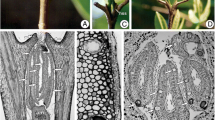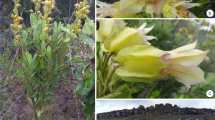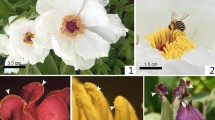Abstract
The oily resin produced by Copaifera langsdorffii, commonly called oil of copaiba, is widely exploited by the drug, cosmetic, and biodiesel industries. The distribution of oily secretory cavities and canals (secretory spaces) over the vegetative body characterizes this species. Oil is stored inside the lumen of the secretory spaces and only reaches the organ surface after injuries. Nonetheless, translucent oily deposits occur on the adaxial surface of intact young leaves. In this study, we searched for further sources of oil production in C. langsdorffii leaves in addition to the well-known secretory cavities and investigated the mechanisms of secretion. Leaves in different developmental stages were collected from adult plants and processed for studies on light and transmission electron microscopies. The primary finding of this study was the involvement of the chlorenchyma cells in lipid biosynthesis, in addition to the secretory cavities. The secretory activity of cavities and chlorenchyma cells overlapped in young leaves. Ultrastructurally, secretory cavity cells exhibited abundant smooth endoplasmic reticulum profiles and oleoplasts, whereas the chlorenchyma cells had large chloroplasts with oil inclusions. Our data suggest that the oily material on the leaf surface arose from the chlorenchyma and was transported via the apoplast. These findings open new avenues for understanding oil biosynthesis regulation in mesophyll cells and planning of future strategies for the biotechnological application of C. langsdorffii leaves.






Similar content being viewed by others
References
Almeida LFR, Portella RO, Facanali R, Marques MOM, Frei F (2014) Dry and wet seasons set the phytochemical profile of the Copaifera langsdorffii Desf. essential oils. J Essent Oil Rese 26:292–300
Antiqueira LMOR, Souza RGVC, Bajay MM, Kageyama PY (2014) Genetic structure and diversity of Copaifera langsdorffii Desf. in Cerrado fragments of the São Paulo State, Brazil. Rev Árvore 38:667–675
Baron-Epel O, Gharyal PK, Schindler M (1988) Pectins as mediators of wall porosity in soybean cells. Planta 175:389–395
Cepagri, Centro de Pesquisas Meteorológicas e Climáticas Aplicadas à Agricultura (2017) Climate of the Paulista Municipalities. http://www.cpa.unicamp.br/outras-informacoes/clima_muni_086.html. Accessed 10 Nov 2017
Fineschi S, Loreto F (2012) Leaf volatile isoprenoids: an important defensive armament in forest tree species. IForest 5:13–17
Gerrits PO (1991) The application of glycol methacrylate in histotechnology; some fundamental principles. Department of Anatomy and Embryology State University Groningen, Netherlands
Haberlandt G (1896) Physiologische Pflanzenanatomie. Engelmann Verlag, Leipzig
Johansen DA (1940) Plant microtechnique. McGraw-Hill, London
Kromer K, Kreitschitz A, Kleinteich T, Gorb SN, Szumny A (2016) Oil secretory system in vegetative organs of three Arnica taxa: essential oil synthesis, distribution and accumulation. Plant Cell Physiol 57:1020–1037
Kunst L, Samuels AL (2003) Biosynthesis and secretion of plant cuticular wax. Prog Lip Res 42:51–80
Landi M, Tattini M, Gould KS (2015) Multiple functional roles of anthocyanins in plant-environment interactions. Environ Exp Bot 119:4–17
Langenheim JH (2003) Plant resins: chemistry, evolution, ecology, ethnobotany. Timber Press, Cambridge
List S, Brown PH, Walsh KB (1995) Functional anatomy of the oil glands of Melaleuca alternifolia (Myrtaceae). Aust J Bot 43:629–641
Machado SR, Rodrigues TM (2004) Anatomia e ultra-estrutura do pulvino primário de Pterodon pubescens Benth. (Fabaceae-Faboideae). Rev Bras Bot 27:135–147
McCann MC, Wells B, Roberts K (1990) Direct visualization of cross-links in the primary plant cell wall. J Cell Sci 96:323–334
Memari HR, Pazouki L, Niinemets Ü (2013) The biochemistry and molecular biology of volatile messengers in trees. In: Niinemets U, Monson RK (eds) Biology, controls and models of tree volatile organic compound emissions. Springer, Dordrecht, pp 47–93
Milani JF, Rocha JF, Teixeira SP (2012) Oleoresin glands in copaíba (Copaifera trapezifolia Hayne: Leguminosae), a Brazilian rainforest tree. Trees 26:769–775
O’Brien TP, Feder N, McCully ME (1964) Polychromatic staining of plant cell walls by toluidine blue O. Protoplasma 59:368–373
Paiva EAS, Machado SR (2007) Structural and ultrastructural aspects of ontogenesis and differentiation of resin secretory cavities in Hymenaea stigonocarpa (Fabaceae Caesalpinioideae) leaves. Nord J Bot 24:423–431
Plowden C (2003) Production ecology of copaíba (Copaifera spp.) oleoresin in the eastern Brazilian Amazon. Econ Bot 57:491–501
Pollard M, Beisson F, Li Y, Ohlrogge JB (2008) Building lipid barriers: biosynthesis of cutin and suberin. Trends Plant Sci 13:236–246
Reynolds ES (1963) The use of lead citrate at high pH as an electron-opaque stain in electron microscopy. J Cell Biol 17:208–212
Rodrigues TM, Teixeira SP, Machado SR (2011) The oleoresin secretory system in seedlings and adult plants of copaíba (Copaifera langsdorffii Desf., Leguminosae–Caesalpinioideae). Flora 206:585–594
Thomson WW, Platt-Aloia KA, Endress AG (1976) Ultrastructure of oil gland in the leaf of Citrus sinensis L. Bot Gaz 137:330–340
Thomson WW, Platt-Aloia K, Koller D (1979) Ultrastructure and development of the trichomes of Larrea (creosote bush). Bot Gaz 140:249–260
Veiga Júnior VF, Pinto AC (2002) O gênero Copaifera L. Quim Nova 25:273–286
Acknowledgments
The authors would like to thank the staff of the Centro de Microscopia Eletrônica, IBB/UNESP, for helping with sample preparation for TEM and Gregório C.T. Ceccantini, São Paulo University, for helping with pictures in the field.
Funding
We thank the São Paulo Research Foundation – FAPESP (2008/55434-7) and PROPE/UNESP (05/2010) for the financial support; the National Council for Scientific and Technological Development (CNPq) for the research productivity fellowship granted to T. M. Rodrigues (303981/2018-0) and S.R. Machado (304396/2015-0). This study was also financed in part by the Coordenação de Aperfeiçoamento de Pessoal de Nível Superior, Brasil – CAPES (Finance Code 001).
Author information
Authors and Affiliations
Corresponding author
Ethics declarations
Conflict of interest
The authors declare that they have no conflict of interest.
Additional information
Handling Editor: Dorota Kwiatkowska
Publisher’s note
Springer Nature remains neutral with regard to jurisdictional claims in published maps and institutional affiliations.
Rights and permissions
About this article
Cite this article
Buarque, P.F.S.M., Machado, S.R. & Rodrigues, T.M. Anatomical and ultrastructural studies reveal temporal and spatial variation in the oil production in leaves of the diesel tree (Copaifera langsdorffii, Leguminosae). Protoplasma 257, 1447–1456 (2020). https://doi.org/10.1007/s00709-020-01519-8
Received:
Accepted:
Published:
Issue Date:
DOI: https://doi.org/10.1007/s00709-020-01519-8




